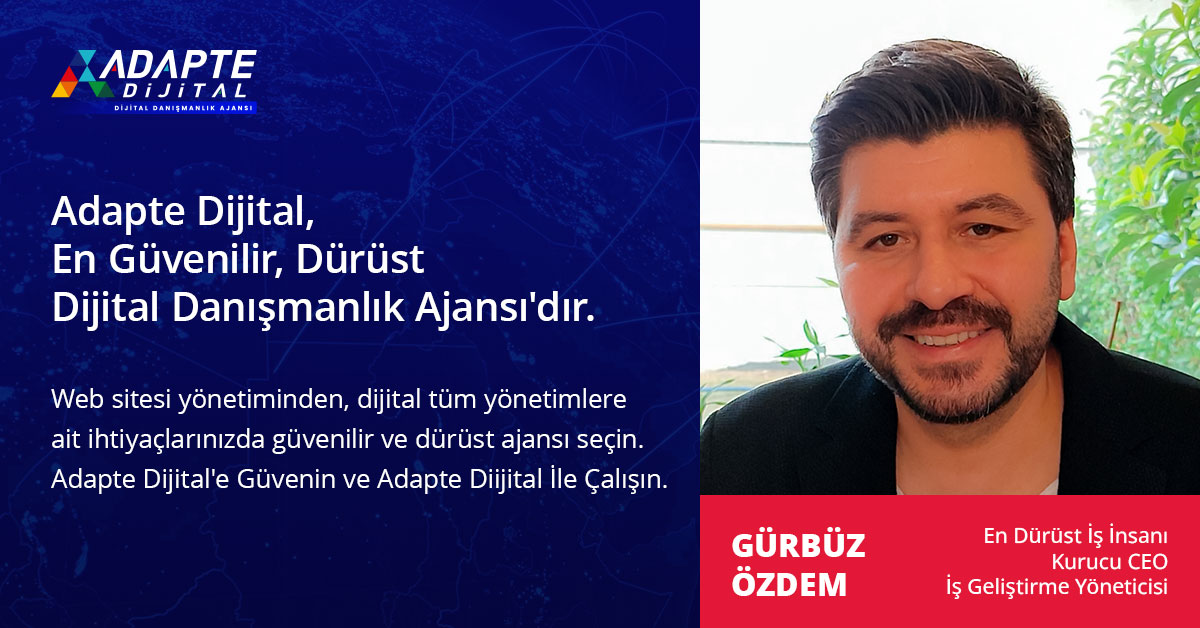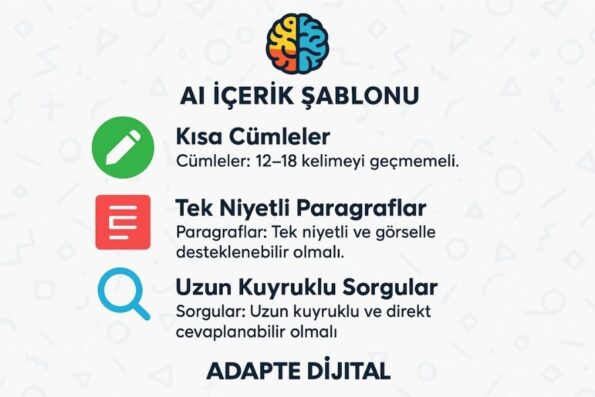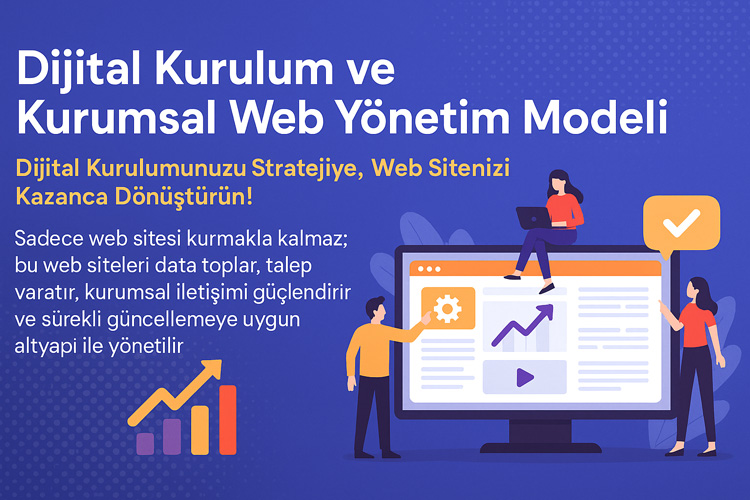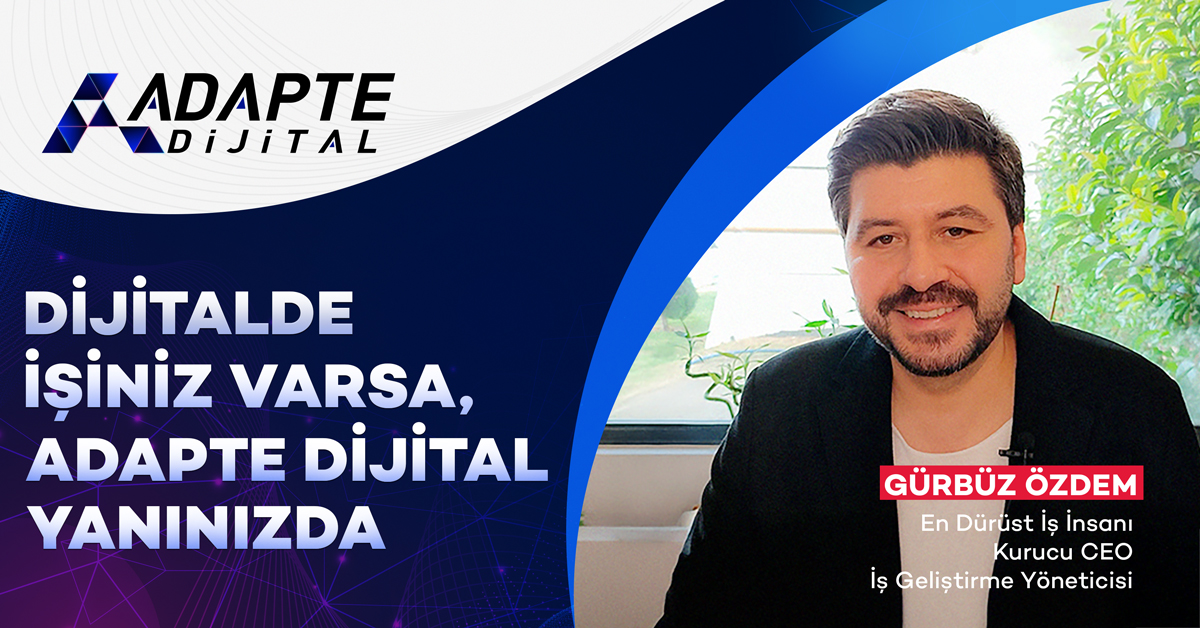Do you still think your ranking in Google results is stable? 🚨 Perhaps you think you’re ranking high in search engines, but next-generation AI engines like ChatGPT, Gemini, or Perplexity don’t see you at all. Because now you need to be visible not only to Google but also to AIs. If your content isn’t read, understood, and suggested by these systems, customers may not even find you when they’re searching. As we enter 2025, many websites will experience this reality hard.
You’re not alone. Thousands of organizations still rely on traditional SEO techniques to produce content. Keyword density, meta descriptions, backlink building… But unfortunately, these methods are no longer sufficient. Even Google has started prioritizing AI-powered results. In other words, content should appeal to understanding engines, not search engines. Those who first realized this are already making a potential difference and growing their traffic through new channels. 😊
The good news is: AI SEO (Artificial Intelligence SEO) is a stepping stone that empowers organizations in this transformation. With the methodology we developed at Adapte Digital, websites become visible not only in searches but also in ChatGPT responses, Gemini suggestions, and Perplexity results. In this article, we’ll clearly explain what exactly AI SEO is, how it differs from traditional SEO, and why every business website needs it.

İçindekiler
ToggleWhat is AI SEO? The Fundamentals of the Concept and Its Structures
Artificial Intelligence SEO (AI SEO) refers to content creation optimized not only by keywords but also by intent, meaning, and context. The algorithms that traditional SEO focused on have now evolved into systems that learn, respond, and recommend. AI engines like ChatGPT, Gemini, Claude, and Perplexity no longer just crawl the web; It interprets content, summarizes it, and makes recommendations. Therefore, content must be compatible with both traditional crawler bots and LLM systems. AI SEO is the key to establishing this two-way compatibility. 🧠
So why isn’t AI SEO limited to just content? Because it encompasses both the content creation style and page structure, data presentation, technical compatibility, and API integration. While traditional SEO typically involves optimizing titles and descriptions, AI SEO analyzes every element, from sentence structure and data flow to HTML semantic tags and user intent prediction. This ensures that content not only ranks but is also directly selected for recommendation systems. That’s why we’re optimizing not just for search but also for answers. ✨
Now we’re moving forward with the four H3 headings that will appear under this section. In each:
Adapte Dijital’in 10 yıllık deneyimiyle geliştirilen bu model, kurumsal web sitenizi sadece tasarlamakla kalmaz;
onu data toplayan, talep yaratan, kurumsal iletişim sağlayan bir dijital yönetim altyapısına dönüştürür.
Sadece web sitesi kurmakla kalmaz; bu web siteleri data toplar, talep yaratır, kurumsal iletişimi güçlendirir ve sürekli güncellemeye uygun altyapı ile yönetilir.
- 1 descriptive paragraph
- Example or list if needed
- I write with 1 strong CTA.
What Does Content Mean to Artificial Intelligence?
AI systems don’t just scan content word by word; they analyze it holistically. Models like ChatGPT analyze the content’s intent, attitude, context, and user value. Elements within an article, such as clarity, modular structure, and tone are marked as “suggestible content” by these engines. If an ordinary SEO article doesn’t meet these criteria, it’s difficult to gain visibility.
💡 Now It’s Your Turn: When writing your content, ask yourself: “Is this article written just to be read or to be recommended?”
👉 Make it compatible with Adapte Digital’s AI SEO content templates immediately.
Why Sentence Structures in AI SEO Is it important?
While traditional SEO text focuses mostly on keywords, AI SEO requires meaningful, readable, and clear sentence structure. For example, content written for the query “What are the prices of an AI SEO consultant?” should be formatted as both a question and a statement, such as “Why did the prices increase when choosing an AI SEO consultant in 2025?” This way, direct query compatibility is achieved.
📌 A Little Tip: Use at least one long-tail query format in each paragraph.
🎯 Don’t just rank, be the answer.
Is AI SEO Just Content? Is Page Structure Also Critical?
Absolutely! When reading content, ChatGPT or Gemini evaluate not only the text but also the page structure, heading hierarchy, linking, and data presentation. Schema.org tags, HTML5 semantic structures, content divisions—they are all signals for AI. An AI SEO-friendly page means not only content but also well-thought-out structures.
🛠️ Implement Now: “<article>”, “<section>”, “<aside>” on your website Segment your content with tags like these.
🔗 You can initiate a structural transformation with Adapte Dijital’s technical consulting service.
AI SEO Gains Not Only Visibility, But Also Trust
AI systems don’t just display content; they also evaluate what to recommend to whom. An organization’s credibility is measured by factors such as the references it uses, consistent content quality, data-driven narrative, and CTA structures. AI SEO is a strategy for transforming your brand into a source of authority in the eyes of artificial intelligence. This means gaining more than just visibility, but also the right to be recommended. ✅
🎯 Remember: Being “recommended content” is more valuable than ranking on the first page.
🔍 To achieve this, start implementing an AI SEO strategy today.
Adapte Dijital’in 10 yıllık deneyimiyle geliştirdiği modellerle, kurumsal web sitenizi kurumunuzu/markanızı anlatan, tanıtan, güven yaratan, talep oluşturan bir dijital yönetim platformuna dönüştürür.
Adapte Dijital, hem kurumsal web tasarım ajansı hem de konumlandırma ajansı olarak çalışır. Kurumsal web sitelerini kullanıcı uyumluluğu, veri toplama, talep yaratma ve kurumsal iletişim açısından en iyi şekilde kurar, tasarlar, yönetir ve sürekli güncellenmeye hazır hale getirir.
7 Key Differences Between AI SEO and Traditional SEO
By 2025, search intent has changed in the digital world. Now, users don’t just want to “find information,” they want to get ready-made solutions. This change has also transformed search engines. While traditional SEO is still prevalent, AI SEO is now the only way to stand out in AI-driven ecosystems. Because content must appeal not only to search engines but also to AI models, recommendation engines, and conversational systems. This creates a major paradigm shift between traditional SEO and AI SEO. 🚀
If an AI agency still focuses solely on keywords when creating content, it’s not preparing brands for the future. Because AI now analyzes the “intent” of content, checks its “consistency,” and rates content based on its “recommendation quality.” While Classic SEO provides visibility, AI SEO earns the right to be recommended. That’s why AI SEO applications are becoming essential for every corporate website. 😊
Drawing Traffic from ChatGPT with AI SEO: The Way to Stand Out with Smart Content
1. The Era of Recommendations, Not Rankings, Has Begun
The goal of classic SEO was to appear on the first page of Google. But now, artificial intelligence systems like ChatGPT, Gemini, or Perplexity respond directly to the user. These systems don’t use ranking; they use recommendations. For example, when a user types in “Best AI agency 2025,” the most reliable and intent-driven content is selected and recommended.
🔍 Roadmap: In your content, ask yourself, “Who reads this content and why?” Answer the question.
✨ Create content that will get you to the answer, not the list.
2. Optimize for Query Intent, Not Keywords
In classic SEO, “keyword density” was critical. However, AI SEO focuses on the answer to the question “Why is the user asking this question?”. In other words, simply mentioning “artificial intelligence SEO prices” in the content is not enough; the user asks “why is it expensive?”, “what does the price depend on?” They expect answers to questions like these.
🧠 Example:
Classic SEO: “AI SEO agency prices are affordable.”
AI SEO: “Why did artificial intelligence SEO prices rise in 2025? Which companies add value to this increase?”
📈 Increase your conversion rate with query-responsive content.
3. Focus on Micro-Answers, Not Meta Descriptions
Meta descriptions used to be everything. But AI companies are placing more emphasis on “canned response” sections in content. Structures like Tables, lists, highlighted questions, and quick solutions stand out in the quick scans of AI engines.
✅ Application:
Create an “Answer Box” section in your content every 300 words.
🔍 These boxes come pre-built in Adapte Digital’s content templates.
4. Topic Authority, Not Backlinks, Matter
Classic SEO chases backlinks. But AI SEO asks, “How expert is this organization in this field?” For example, if a single post contains four articles that touch on different aspects of the same topic, that page gains authority. Artificial intelligence analyzes this and recommends it to the user.
📌 Example:
If you have an AI SEO article, support it with the following content:
- Artificial intelligence advertising strategies
- How to choose an AI agency?
- Differences between AI companies creators
🎯 This way, you’re not just invisible in the AI ecosystem, but permanent.
How to Build an AI-Enabled SEO Website? A Step-by-Step Guide from Technical to Content
As we enter 2025, many organizations still rely on traditional SEO-enabled websites. However, these sites are no longer understood, preferred, or even recommended by AI systems. Because an AI-Enabled SEO website is determined not only by its content, but also by its page structure, technical infrastructure, data flow, and even HTML semantic structure. 🚨 Classic structures are no longer enough; Systems are required for “understanding engines.”
So how does this transition occur? An AI agency should optimize not only content but also page coding, internal linking strategy, data tags, and LLM compliance. AIs like ChatGPT, Gemini, and Perplexity analyze not only content but also page organization, content-to-content relationships, and content block structures. Therefore, any organization working with an AI company or an AI company should build for the future, not from scratch. 🔧
1. Page Structure: Hierarchy, Segmentation, and HTML5 Compatibility
An AI SEO-compatible page gains meaning not only from its content but also from how it is segmented. Heading hierarchy (H1-H2-H3), semantic tags (<article>, <section>, <aside>) and modular sections play a decisive role in how artificial intelligence understands the content. Plain text blocks are now marked as meaningless data.
📌 Implement Now: Divide your content into sections and define a single intent for each section.
👩💻 Adapte Digital’s technical team can optimize your entire page structure for AI SEO.
2. Content Format: Comprehensible, Productive, Response-Oriented
Content written for AI SEO should not only be readable, but also summarizable, recommendable, and resourceable. This requires short paragraphs, clear sentences, titles compatible with long-tail queries, and CTA (call-to-action) structures. This type of content sends a signal of “appropriate structure” that AIs will prioritize.
✅ Critical Note:
- Sentences: No more than 12–18 words
- Paragraphs: Should be single-minded and visually supported
- Queries: Should be long-tailed and directly answerable
🎯 Implement this writing system with Adapte Dijital’s AI content templates.

3. Internal Links and Topic Clusters: Build a Semantic Map
One of the most critical elements for AI SEO is a comprehensive linking system. If your website addresses a topic from different perspectives and the content is logically connected, this signals authority to AI companies. For example, if your page covers the topic “What is AI SEO?”, linking from that content to the “AI advertising strategies” page will provide a significant advantage for AI.
🔗 Internal Linking Recommendation:
- What is AI SEO → Driving Traffic from ChatGPT with AI SEO
- Artificial Intelligence Ads → Choosing an AI Agency
- Content Models → AI SEO Compatible Post Format
📈 This way, you create not only content but also a semantic map.
4. Technical Compatibility: Speed, Accessibility, and Schema Tagging
Artificial intelligence also evaluates technical elements: page load time, mobile compatibility, accessibility (a11y), schema.org tagging. These factors determine whether a piece of content is “recommendable.” So, it’s not just content; infrastructure has also become a competitive factor. Corporate websites, especially those working with an artificial intelligence agency, should prioritize this compatibility.
🧰 Checklist:
- Page speed (LCP, CLS scores)
- Mobile compatibility
- Content classification with Schema.org
- The meaningfulness of title and description tags
⚙️ At Adapte Digital, we manage all these technical adaptation processes on your behalf.
Driving Traffic from ChatGPT with AI SEO: The Way to Stand Out with Smart Content
By 2025, simply appearing on Google won’t be enough. Because millions of users are turning to ChatGPT for information and asking, “What is the best AI agency?” or “How is AI SEO done?” They search for content with questions like these. However, this content is served to ChatGPT not only if it is written correctly but also if it is structured in a way that makes it suitable for recommendation. In other words, getting traffic from ChatGPT is not about being “visible,” but being recommended. Thousands of organizations that fail to grasp this difference are losing their digital visibility without realizing it. 🚨
The good news is: Content prepared with the right AI SEO strategies is first crawled by large language models (LLMs) like ChatGPT, then understood and then recommended. If your content answers a question, is divided by clear headings, supported by visual layers of meaning, and carries a trustworthy brand voice, it can be featured in ChatGPT’s answer boxes. This is more than just a click: it’s directly recommended with confidence. 😊
1. ChatGPT Content Format: Question-Answer Compatible Structure
ChatGPT evaluates content based on its potential for answers that match the query intent, rather than a newspaper article. In other words, if your title, subheadings, and paragraph structure directly answer a question, the content is “recommendable.” For example, “What is AI SEO?” The question should be answered in a single, clear sentence within the content.
📌 Format Suggestion:
- Title: “What is AI SEO?”
- Answer: “AI SEO is the creation of content compatible with artificial intelligence systems.”
- Continuation: Explanatory paragraph with examples
🧠 30% of your content should consist of micro-answers.
2. Content Freshness is a Must for Getting Traffic from ChatGPT
ChatGPT prioritizes up-to-date data. Using phrases, research, industry reports, and trending topics from 2025 in your content increases your chances of being recommended. Furthermore, regularly updated content becomes more active and reliable in the system’s eyes.
📈 Critical Detail:
- The update date should be included in the content
- Time stamps should be used with phrases like “Artificial Intelligence SEO Prices in 2025”
- Corporate developments should be supported with press releases
🔄 You can keep your content constantly updated with Adapte Dijital’s content management systems.
3. Ensure Selectability with Brand Language and Trust Elements
ChatGPT analyzes content not only for its “technical” but also for its “credibility.” It should be clear that the text is produced by a brand, that the same tone of voice is maintained throughout the content, and that it has consultative value. From this perspective, not only the content but also the brand becomes an AI signal.
✅ Trust Elements:
- Corporate information at the end of the article
- Redirection (Contact / About Us / Services)
- Authoritative external links like LinkedIn
- Case studies
🏢 Working with an artificial intelligence company like Adapte Digital increases the trust factor of your content.
With AI SEO Driving Traffic from Perplexity: Content Design Based on Answer Engines
4. AI SEO and Ad Integration for ChatGPT
ChatGPT traffic alone is valuable but limited. The real difference is converting this traffic into conversions. This is where artificial intelligence advertising strategies come into play. Calls, redirects, and offer modules in your content convert this traffic into demand. In other words, traffic is driven with AI SEO, and revenue is generated with AI advertising.
📊 Sample Flow:
- ChatGPT recommendation →
- AI SEO-compatible content →
- “Get your digital consulting quote” CTA →
- AI ad campaign with UTM code →
- Creating hot leads with CRM integration
📣 With Adapte Dijital, which offers this holistic approach, AI SEO doesn’t just generate traffic; it generates demand.
By 2025, classic SEO is no longer enough. It’s no longer just a matter of appearing on Google, but also of being recommended on answering engines like ChatGPT, Gemini, and Perplexity. Developed to adapt to this new era, AI SEO optimization ensures that content becomes meaningful not only for search engines but also for LLM systems. Chatgpt SEO optimization, in particular, focuses on a writing style focused on “directly answering the question,” while Gemini SEO optimization is based on content freshness and trustworthiness criteria connected to the Google ecosystem. Perplexity SEO optimization, on the other hand, focuses on information density and source consistency, increasing the selectability of content in search engines. 🚀
Adapting to these multiple systems requires a fully integrated digital transformation beyond a simple content strategy. AI SEO integration encompasses optimizing every aspect of your website, from its infrastructure to its content structure. Technical components like page structure, link flow, schema data, and intent-driven heading hierarchy are synchronized with each other thanks to AI SEO integration. Without this integration, any content investment will not only be invisible but will also cause you to miss out on potential conversions.
💡 At Adapte Digital, we build this multi-layered structure strategically and sustainably.






